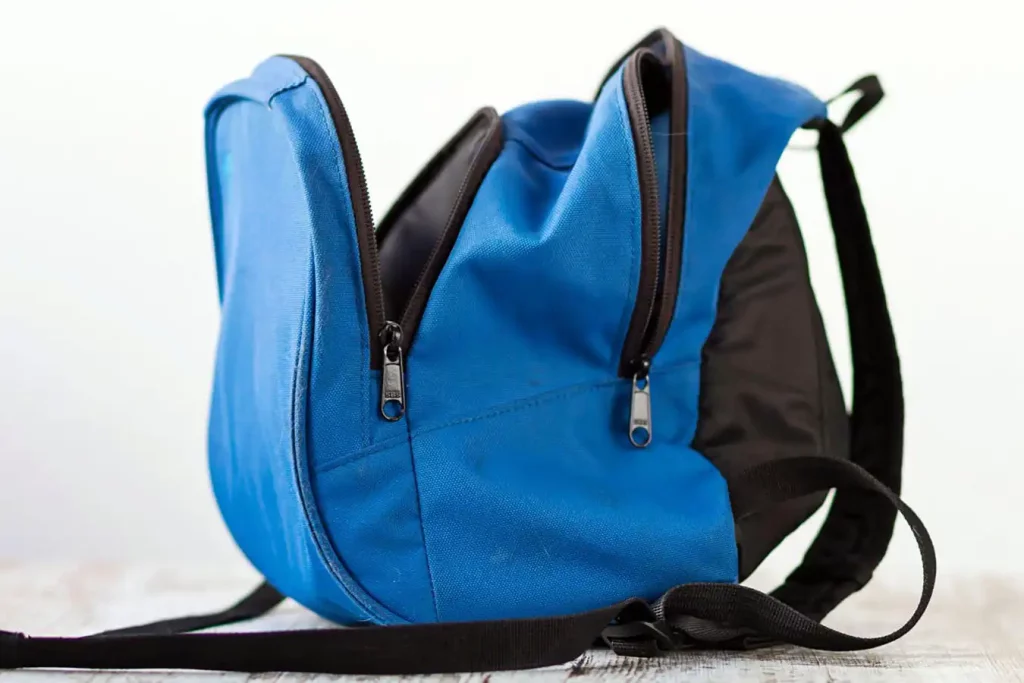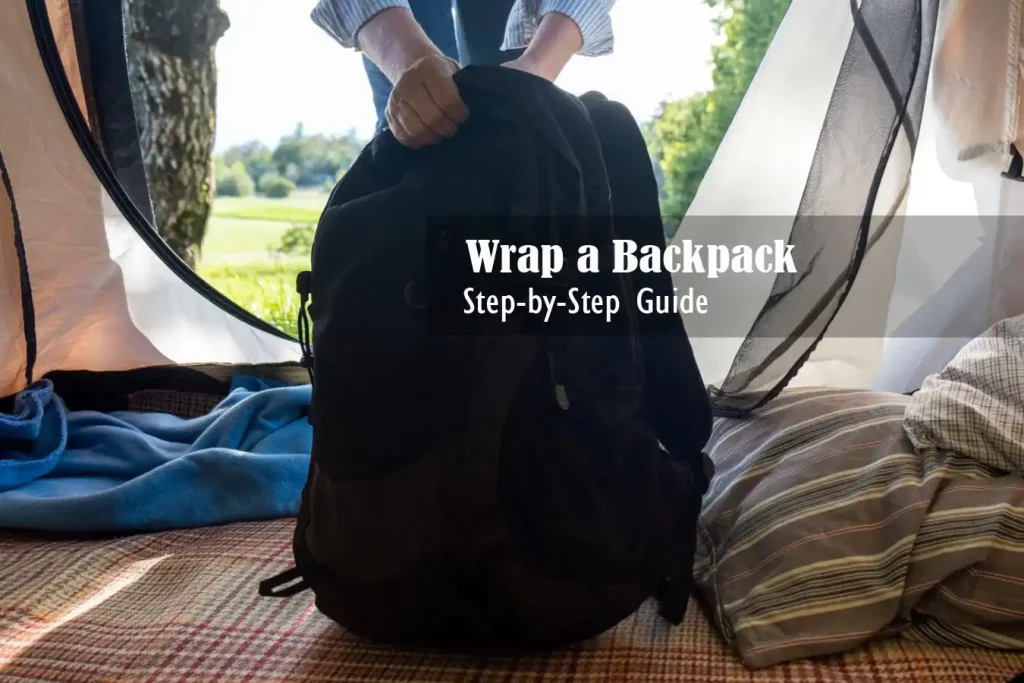Ever tried figuring out how to wrap a backpack and just ended up tangled in plastic and tape?
Yeah, we've been there.
Getting it right isn't just about keeping things dry; it's also about keeping your stuff safe.
It's like giving your backpack a protective armor before it heads into battle – be it rain, dirt, or just a packed subway.
Stick with me, and we'll make sure your bag's got the best wrap game in town.
Trust me, your future adventures (and your belongings) will thank you.
The Purpose of Wrapping a Backpack
We often don't give much thought to our sturdy backpacks, do we? They carry our essentials, endure harsh weather conditions, and even suffer the occasional spill. So, isn't it high time we return the favor and give them some protection? That's exactly where backpack wrapping comes in. It's all about protecting our faithful travel companion and making our journey smoother.
In this guide, we'll walk you through the reasons why you should wrap your backpack and, of course, the actual wrapping process. Buckle up, because this is going to be one enlightening journey!
Why is Wrapping a Backpack Important?
Protecting Your Backpack and Belongings
Ever noticed how your backpack suffers on a muddy hiking trail, a crowded train, or even the unforgiving conveyor belts at the airport? From dirt and rain to rough handling and accidental spills – your backpack endures a lot. By wrapping it properly, you can protect it from these external factors, prolonging its lifespan and ensuring the safety of your belongings inside. Think of the wrap as a superhero's shield, standing strong against any potential harm.
Convenience and Practicality of a Wrapped Backpack
Believe it or not, a wrapped backpack is more than just a protected backpack. It's about practicality and convenience. Wrapping can keep your backpack compact, preventing those annoying snags and tears when navigating through tight spaces. Plus, it's easier to spot on a luggage carousel, especially if you use a colorful or unique wrap.
Different Situations that Require Wrapping a Backpack
Now that you understand the importance of wrapping a backpack, you might be wondering, “When exactly should I do it?” Well, there are a few scenarios where this knowledge comes in super handy.
Backpack Wrapping for Travel (Air, Train, Car)
If you're a frequent traveler, you know that your backpack can take a beating during transit. Whether it's by air, train, or car, your backpack is exposed to various potential damages – scratches from rough surfaces, stains from spilled drinks, or even theft.
Wrapping your backpack can shield it from these risks and keep your belongings secure. Plus, let's not forget about those turbulent weather conditions. A wrapped backpack can withstand a sudden downpour or dust storm much better than an unwrapped one.
Backpack Wrapping for Storage or Shipping
Even if you're not on the move, backpack wrapping still proves beneficial. Perhaps you're storing your backpack away for a while, or maybe you're shipping it across states or countries. In such cases, wrapping helps keep your backpack clean and dust-free, not to mention safe from any accidental spills or mishaps that might occur during transport.
Materials You Need for Wrapping a Backpack
Alright, we're getting closer to the fun part – the actual wrapping process! But before we delve into that, let's discuss the materials you'll need.
Selection and Importance of Wrapping Materials
You'll primarily need a strong, durable material to wrap your backpack. There are several options available, from backpack covers and rain covers to specialized wrapping plastic. Each has its own benefits. Backpack covers are often waterproof and come in various sizes, making them ideal for travel, while wrapping plastic can provide a tighter seal for long-term storage or shipping.
Whichever material you choose, make sure it's strong, durable, and waterproof. After all, it's this material that will act as your backpack's armor, defending it from all potential harm.
Where to Purchase or Find these Materials
These wrapping materials can easily be found online on websites like Amazon, eBay, or outdoor adventure gear shops. Local travel or outdoor stores might also stock them. Just remember, investing in a good-quality wrap is like investing in the longevity of your backpack, so don't shy away from spending a little extra if it means better protection for your faithful travel buddy.
Now that we've got the basics covered, stay tuned for the main event – the step-by-step guide on how to wrap a backpack!
Step-by-Step Guide: How to Wrap a Backpack
Finally, we've arrived at the core section of our guide, where we'll demystify the process of wrapping a backpack. Let's dive straight in.
Preparing Your Backpack for Wrapping (Emptying, Cleaning, etc.)
Before you start the actual wrapping, it's essential to prepare your backpack. Start by emptying it completely. Check all the pockets – yes, even that sneaky little one you always forget about – and make sure you've removed everything. After all, you don't want to find a month-old sandwich or a forgotten USB drive after you've wrapped up your backpack!

Next, give your backpack a good clean. Shake out any crumbs or dirt, wipe down the interior and exterior with a damp cloth, and let it dry completely. Not only will this keep your backpack fresh, but it also ensures that dirt and moisture won't be trapped inside during wrapping.
Detailed Instructions on the Wrapping Process
Once your backpack is clean and dry, you can start wrapping it. Here's a step-by-step guide:
- Place your backpack on a flat surface: This will give you a solid base to work with and make the wrapping process easier.
- Spread out your wrapping material: Whether it's a backpack cover or wrapping plastic, spread it out on the surface.
- Place the backpack in the center of the material: Ensure that the material covers your backpack entirely.
- Begin wrapping: Start from the top, making sure that all straps and zippers are enclosed. If you're using wrapping plastic, wrap it around the backpack several times to create a secure shell. If it's a backpack cover, secure it according to the manufacturer's instructions, which usually involves tightening straps or zippers.
- Secure the wrapping: If using plastic wrap, tape the end down securely. For a backpack cover, ensure that all fasteners are secure.
Safety and Precautions when Wrapping a Backpack
Though wrapping a backpack is pretty straightforward, there are a few precautions to keep in mind. First, be gentle when wrapping. You don't want to damage your backpack by pulling too hard on the straps or zippers. If you're using plastic wrap, avoid wrapping too tightly as this might cause pressure on the seams of your backpack.
Finally, don't forget to check your backpack after wrapping. Make sure there are no holes or gaps where dust or moisture could get in. And that's it – you've successfully wrapped your backpack! Your trusty travel companion is now ready for whatever journey lies ahead, whether it's a backpacking trip across Europe or a few months in storage.
Unwrapping Your Backpack
As important as it is to know how to wrap your backpack correctly, it's equally essential to understand how to unwrap it without causing any damage. Let's talk about how you can do this and what you can do with the used wrapping materials.
Correct and Safe Ways to Unwrap Your Backpack
Unwrapping your backpack might seem like a straightforward task, but it can be done in ways that prevent unnecessary wear and tear on your backpack.
- Don't rush: Patience is key! Unwrap carefully and take your time. If you've used tape, avoid pulling it off hastily to prevent damaging the backpack's material.
- Use tools if needed: If your backpack is tightly wrapped with plastic or a backpack cover, it might be helpful to use a pair of scissors to help cut the wrap gently. Be careful to avoid cutting or scratching your backpack.
- Check as you unwrap: As you unwrap, look out for any trapped zippers or straps, and release them gently.
What to Do with the Used Wrapping Materials
Once you've unwrapped your backpack, you'll have some used wrapping materials left. If you've used plastic wrap, you can recycle it if your local recycling facility accepts this type of plastic. If you've used a backpack cover, clean it following the manufacturer's instructions, and store it for future use. Remember, reusing and recycling are always better options than discarding!
FAQs about Wrap a Backpack
How do you wrap a travel bag as a gift?
How do you wrap a hiking backpack?
How do you pack a backpack for delivery?
How do you wrap a bag in wrapping paper?
Conclusion
There you have it, your complete guide to wrapping a backpack. From understanding the importance of protecting your backpack to the step-by-step guide on how to do it, and even the best way to unwrap it, you're now equipped with everything you need to ensure your backpack stays in the best possible condition, no matter where you're heading.
So, whether you're about to embark on a cross-country adventure, take a quick weekend trip, or just need to safely store your backpack away, you can now do so with the confidence that you're providing the best care for your travel companion. Here's to happy and safe travels!
Read next: What Size is a Standard Backpack


